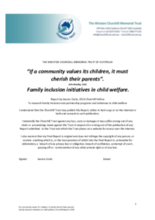It is widely agreed that there are too many children and young people in out of home care in Australia and that rates of restoration home are too low. It is also accepted that children have a right to be cared for by their families whenever this is safe and for their families to be supported to be the best families they can be. Even when children stay in care and cannot go home, it is vital for them to know and have relationships with their families, especially their parents and siblings. This Churchill Fellowship has explored family inclusion initiatives in the USA, Canada, Norway and the UK and has found that family inclusion is a pathway to better outcomes for children and young people including restoration and permanency.
This fellowship has explored a range of initiatives and programs that aim to build a family inclusive approach to child protection and out of home care (child welfare) practice especially when children have been removed by statutory child welfare agencies and placed in care. This project focused on three key areas:
- Peer work in child welfare - Peer workers are defined as parents who have had personal experiences with the child welfare system and offer advocacy and support to parents currently involved in the system.
- Child focused relationship building between birth parents and foster or other types of carers when children are in care
- Parent leadership – in the interests of children
These areas are inter related and do overlap at times. This project explored initiatives within the system, direct service provision as well as coalitions and activism aimed at improving the system. Many agencies and programs provide direct services to help child welfare involved parents and their children and they also lobby and advocate for systemic change to improve the system overall.
The project has revealed a range of practical ideas and strategies to be considered for implementation in Australia. Many of these strategies can be implemented within current resources and have the potential to bring about significant and long lasting positive change for children and families.

